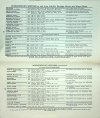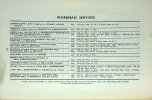Just got a 1941 West Yorkshire Road Car timetable. I am comparing it to a 1936 one I also have. quite a lot missing.
When did shortages really start to bite, staff and buses? I know many buses went to London to replace those lost in bombing. But by 1941?
And when were men getting called up in big numbers? And when were women driving buses in large numbers?
The 1936 one is already on Timetable world. The 1941 will be in the next release, around December. When I have scanned it!
When did shortages really start to bite, staff and buses? I know many buses went to London to replace those lost in bombing. But by 1941?
And when were men getting called up in big numbers? And when were women driving buses in large numbers?
The 1936 one is already on Timetable world. The 1941 will be in the next release, around December. When I have scanned it!








